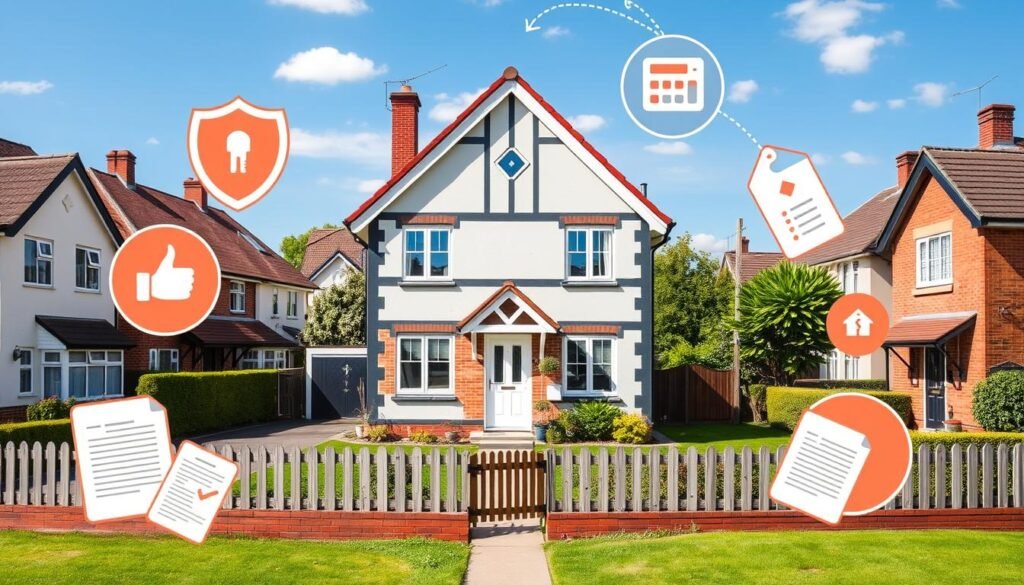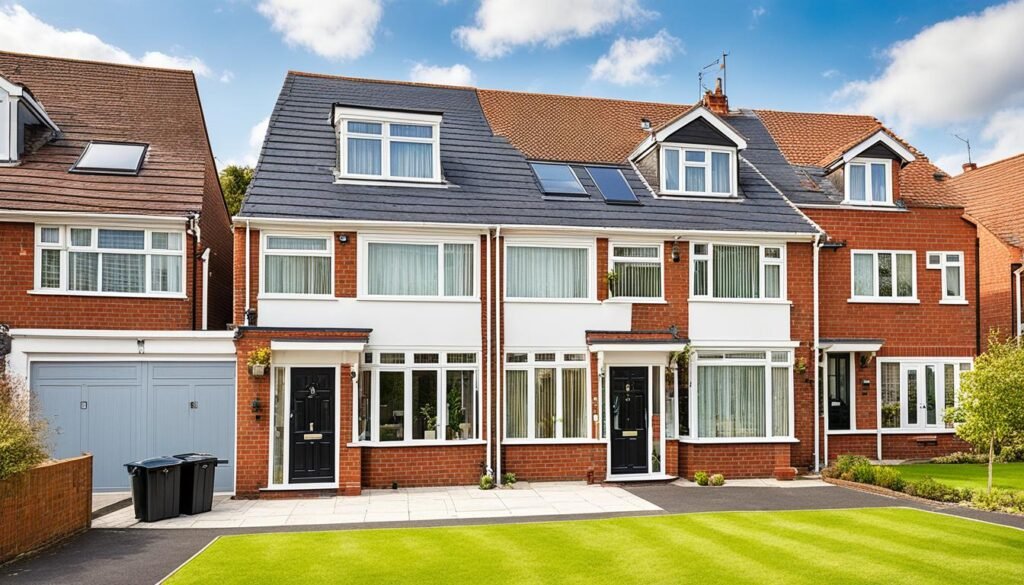EPC Upgrades
Key Takeaways:
- Nearly 3 million rental homes need upgrading to meet new EPC targets
- Estimated cost of £23.4 billion, averaging £8,074 per property
- Government plans for all rented properties to have EPC rating of C or above by 2030
- Challenges include practicality, cost, and potential landlord exodus
As a UK landlord, you’re facing a significant challenge: the government’s ambitious plans for energy efficiency upgrades. This guide will help you navigate the complexities of EPC improvements, understand the potential costs, and explore strategies to meet these new requirements.
The £23.4bn EPC Upgrade Challenge: What Landlords Need to Know
The UK government has set a target for all rented properties in England to achieve an Energy Performance Certificate (EPC) rating of C or above by 2030. This ambitious goal is set to have a massive impact on the buy-to-let sector, with Rightmove estimating that nearly 3 million rental homes will need upgrades.
The scale of this challenge is staggering. Rightmove‘s analysis suggests that landlords collectively face a bill of £23.4 billion to bring their properties up to standard. That’s an average of £8,074 per property – a significant investment for any landlord.
While the intention behind these upgrades is commendable – improving energy efficiency and reducing carbon emissions – the practicalities of implementing such widespread changes are daunting. As a landlord, you’ll need to carefully consider how these requirements will affect your property portfolio and business strategy.

Understanding EPC Ratings and the 2030 Deadline
EPC ratings are a measure of a property’s energy efficiency, ranging from A (most efficient) to G (least efficient). Currently, rental properties must have a minimum EPC rating of E, but the government’s new plans aim to raise this bar significantly.
The proposed 2030 deadline for achieving a C rating or above is ambitious, to say the least. It’s important to note that this timeline may be subject to change or adjustment as the practicalities of such a large-scale upgrade become apparent.
As a landlord, you should start assessing your properties now. Understanding your current EPC ratings and what improvements might be needed will help you plan and budget effectively. Remember, early action could save you from a last-minute scramble as the deadline approaches.
The Financial Impact on Landlords: Breaking Down the Costs
The estimated average cost of £8,074 per property is a significant figure, but it’s important to remember that this is just an average. The actual cost for your properties could vary widely depending on their current condition, size, and specific upgrade requirements.
Common upgrades that might be needed include:
| Upgrade Type | Estimated Cost Range |
|---|---|
| Loft Insulation | £300 – £600 |
| Cavity Wall Insulation | £500 – £1,500 |
| Double Glazing | £3,000 – £7,000 |
| New Boiler | £2,000 – £3,000 |
| Heat Pump Installation | £6,000 – £18,000 |
These costs can quickly add up, especially if you own multiple properties. It’s crucial to start budgeting for these improvements now, even if the deadline seems far off.
Challenges and Concerns: Is the 2030 Goal Realistic?
While the government’s ambition is clear, there are significant challenges in implementing these changes across the entire rental sector. Some key concerns include:
- Practicality for older properties: Many older homes may struggle to achieve a C rating regardless of improvements made.
- Potential unintended consequences: Some energy efficiency measures can lead to issues like damp if not correctly implemented.
- Disruption to tenants: Major upgrades often require properties to be vacated, causing inconvenience and potential loss of rental income.
- Skills shortage: There may not be enough qualified professionals to carry out all the required work by 2030.
- Funding gap: Many landlords may struggle to finance these improvements, especially those with multiple properties.
Given these challenges, it’s possible that the government may need to reassess its timeline or provide additional support to landlords.

Strategies for Landlords: Planning for EPC Upgrades
As a landlord, it’s crucial to start planning for these upgrades now. Here are some strategies to consider:
- Assess your portfolio: Get up-to-date EPC assessments for all your properties to understand the scale of improvements needed.
- Prioritise improvements: Focus on properties that need the least work first, to spread costs over time.
- Research funding options: Look into any available grants or low-interest loans for energy efficiency improvements.
- Consider incorporating upgrades into routine maintenance: Where possible, align energy efficiency improvements with your regular property maintenance schedule.
- Stay informed: Keep up to date with any changes to legislation or deadlines, as well as new technologies that might make upgrades more cost-effective.
The Potential Exodus: Will Landlords Sell Up?
One concerning trend highlighted by Rightmove is the increasing number of landlords considering selling their properties rather than investing in upgrades. In fact, the proportion of former rental properties entering the sales market is at its highest point on record.
This trend is particularly pronounced in London, where nearly a third of homes for sale were previously rental properties. If this trend continues, it could lead to a significant reduction in available rental properties, potentially driving up rents for tenants.
As a landlord, you’ll need to carefully weigh the costs of upgrades against the potential returns from your rental property. In some cases, selling may indeed be the most financially sensible option, but it’s important to consider the long-term implications for both your business and the broader rental market.
Government Support: What Help is Available for Landlords?
Currently, there’s limited direct financial support available for landlords to make these upgrades. However, the government has indicated that it will be consulting on its plans, which may lead to the introduction of support measures.
Potential forms of support that have been suggested include:
- Grants or low-interest loans for energy efficiency improvements
- Tax incentives, such as allowing landlords to offset improvement costs against income tax
- Stamp duty rebates for buyers who make green improvements soon after purchase
It’s worth keeping an eye on government announcements and consulting with property professionals to stay informed about any new support measures that become available.
The Tenant Perspective: Benefits and Responsibilities
While much of the focus is on landlords, it’s important to consider the tenant perspective as well. Energy-efficient homes can offer significant benefits to tenants, including:
- Lower energy bills
- Improved comfort, particularly in winter
- Reduced carbon footprint
However, tenants also have responsibilities when it comes to energy efficiency. They should:
- Use heating and cooling systems efficiently
- Report any issues that might affect energy efficiency (e.g., draughty windows)
- Seek permission before making any changes to the property
As a landlord, clear communication with your tenants about energy efficiency can help ensure that your property performs as intended.

Looking Ahead: The Future of Rental Property Energy Efficiency
While the current focus is on achieving a C rating by 2030, it’s likely that energy efficiency standards will continue to evolve. Future regulations might push for even higher standards, potentially aiming for B or even A ratings.
As technology advances, new solutions for improving energy efficiency are likely to emerge. These might include:
- More efficient heating systems
- Advanced insulation materials
- Smart home technologies for better energy management
Staying informed about these developments can help you make future-proof decisions when upgrading your properties.
Balancing Costs and Benefits: Making Informed Decisions
As you navigate these challenges, it’s important to take a balanced approach. While the upfront costs of upgrades can be significant, they can also bring benefits:
- Improved property value
- Higher rental potential
- Lower vacancy rates (as tenants seek more efficient homes)
- Future-proofing against tighter regulations
Consider each property in your portfolio individually, weighing the costs of upgrades against these potential benefits. In some cases, it might make sense to invest heavily in improvements, while in others, selling might be the better option.
Key Takeaways for UK Landlords
- Start planning now: Don’t wait until the deadline approaches to assess your properties and plan upgrades.
- Budget carefully: The average cost of £8,074 per property is significant – start setting aside funds now.
- Stay informed: Keep up to date with changes in legislation and available support.
- Consider the long-term: Balance the costs of upgrades against potential benefits and future regulations.
- Communicate with tenants: Ensure your tenants understand the benefits of energy efficiency and their role in maintaining it.
As a UK landlord, you’re facing a significant challenge with the new EPC requirements. However, with careful planning, informed decision-making, and a proactive approach, you can navigate these changes successfully. Remember, improving energy efficiency isn’t just about meeting regulations – it’s an investment in the future of your property portfolio and the well-being of your tenants.
Frequently Asked Questions
- Q: What is the deadline for rental properties to achieve an EPC rating of C?
A: The current proposal sets the deadline at 2030 for all rented properties in England to have an EPC rating of C or above. - Q: How much is it estimated to cost landlords to upgrade their properties?
A: Rightmove estimates an average cost of £8,074 per property, with a total cost of £23.4 billion across the sector. - Q: What happens if I can’t afford to upgrade my property?
A: The government has not yet clarified consequences for non-compliance. However, it’s possible that properties failing to meet the standard may not be able to be legally let after the deadline. - Q: Are there any exemptions to the EPC C requirement?
A: Currently, there are exemptions for some listed buildings and properties where it’s not feasible to make improvements. However, specific exemptions for the new C rating requirement have not yet been confirmed. - Q: Can tenants make energy efficiency improvements themselves?
A: Tenants should always seek permission from their landlord before making any changes to the property, including energy efficiency improvements.




